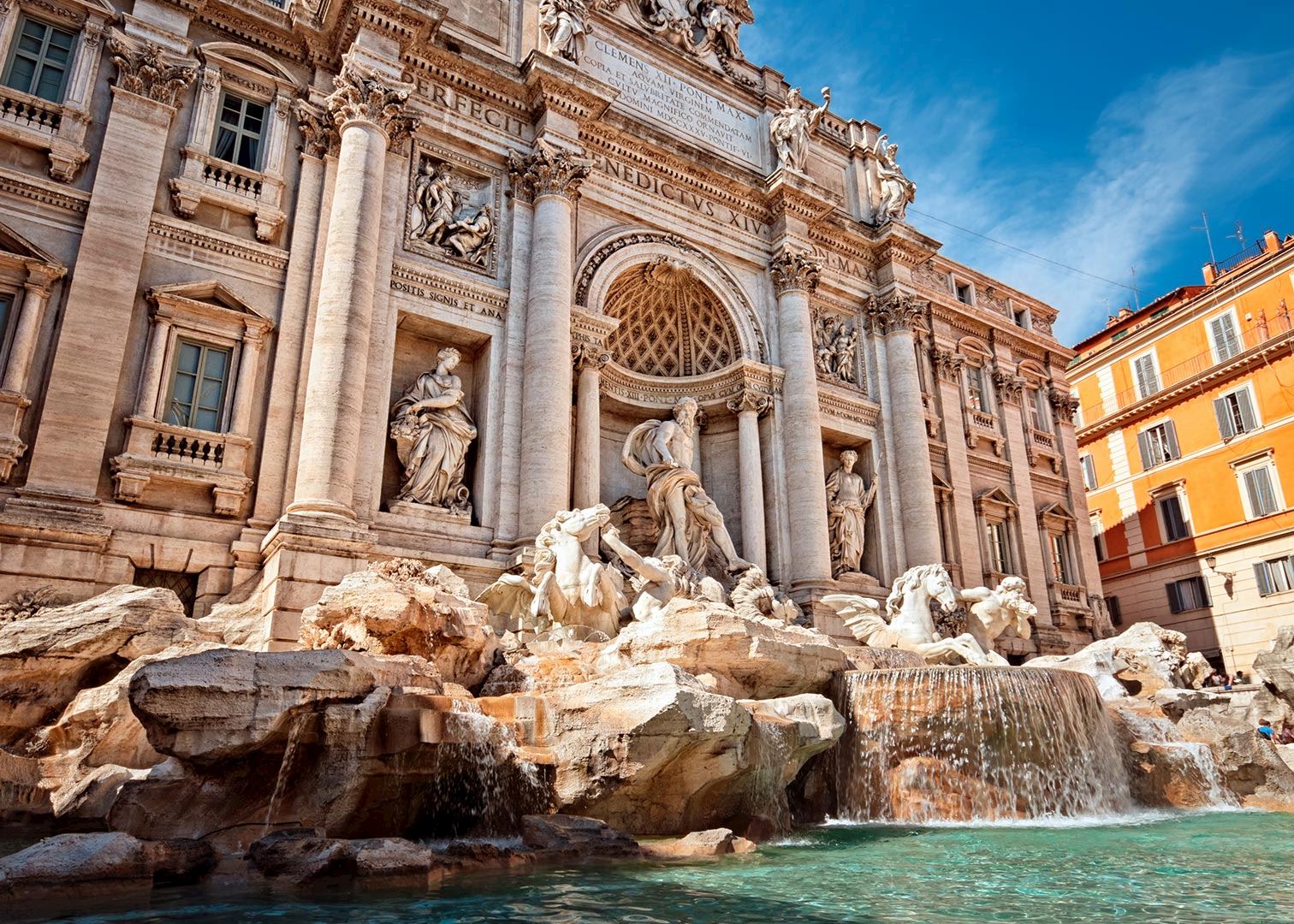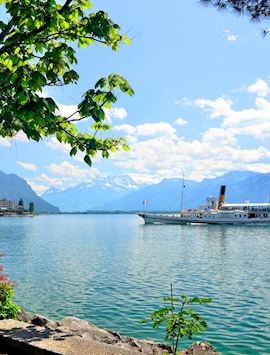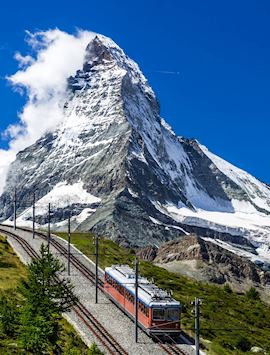Lowing cows grazing in flower-dotted valleys, chocolate-box dairy villages nestled amid the soaring mountains, and cosmopolitan cities on mirror-like glacier lakes... Switzerland is a small country, but it has much to see and do packed into its compact borders.
In the sky-scraping Swiss Alps to the south, you can walk on massive glaciers, visit traditional dairies, ride lifts to renowned mountain peaks and enjoy the Alpine scenery via panoramic train. Or, to get to know the Swiss people and cuisine, head to the country’s cities, where you can discover how bordering nations have influenced the country’s food.
Montreux on Lake Geneva

Known to locals as Lac Léman, Lake Geneva’s half-moon curve marks part of the border between Switzerland and France. Its glittering waters have attracted visitors for more than a century, who come to enjoy the mild climate and plentiful sun.
Montreux, on the far eastern end, was a small lakeside town until it became popular with the glitterati of the 19th century, including the Shelleys and Lord Byron. The resulting popularity resulted in a Belle Époque building boom in the old town, and as you stroll the cobblestone lanes, you can still admire the era’s buildings with their lace-like wrought-iron balconies.
The town is nestled at the base of the Alps, but the climate feels more like the Riviera, thanks to the mild temperatures. The warmth of the sun bouncing off the lake creates a microclimate along this stretch of coast that’s balmy enough to support Switzerland’s wine region. (Read on for more about this little-known industry.)
From the lakefront, you can follow a flower-lined promenade known as Chemin Fleuri, which snakes south along the coast, until you reach Chillon Castle. The namesake for Byron’s Prisoner of Chillon, this massive stone fortress makes a striking silhouette against the brooding mountains in the background — a scene that’s been captured by countless painters, including William Turner.
What to do in Montreux: An alpine adventure land, Glacier 3000 offers a chance to ride a gondola to a bridge suspended between two soaring mountain peaks. You could also hike across the glacier, try your hand at dog-sledding, or ride a toboggan.
Where to stay in Montreux: Located within easy walking distance of the lake and the old town of Montreux, Villa Toscane is a small, Art Nouveau hotel with sumptuous amenities that include a luxe spa.
Lugano
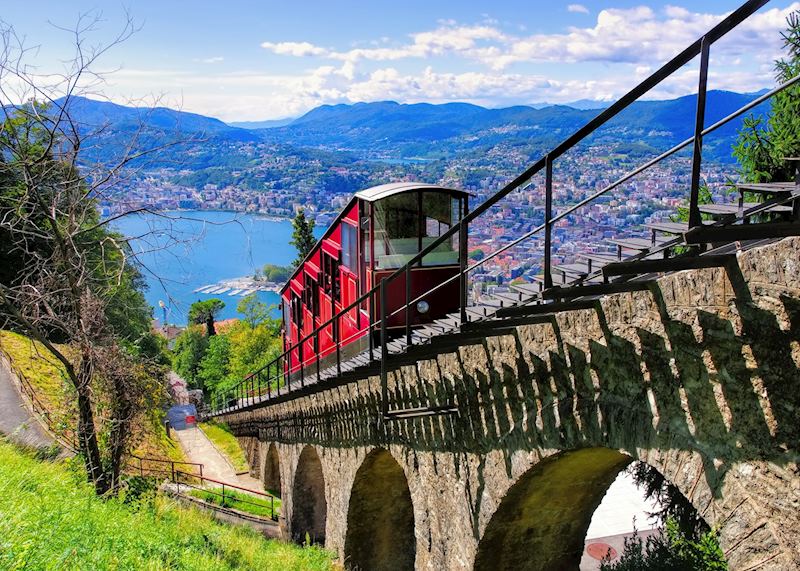
Nestled in a valley in the southern tip of the country, Lugano seems to belong to Italy’s gentle climes rather than to Switzerland’s Alpine reputation. The town sits on a sunny lake, fringed with palm trees, and the culture and cuisine both boast a very Mediterranean slant. In fact, the population here speaks Italian, one of Switzerland’s four official languages.
The lake here is a major draw, providing a playground for boating, swimming and other water sports in the warm summer months. You can also take a funicular to the peak of Monte Brè and Monte San Salvatore — the two bordering mountains — for incomparable views of the town.
A guided food tour of the town offers a chance to sample local cuisine and get your bearings in the tangled web of cobblestone streets. You can also take a day’s jaunt into Italy to see nearby Lake Como and Milan.
For the most quintessential Lugano experience, take a cruise out to one of the traditional grottoes that line the lake’s shores. These simple eateries are a local institution, descended from one-time caves carved into the stone where locals stored food. Today, they serve a very simple, limited menu of Ticinese dishes made from local ingredients.
What to do in Lugano: Cruise to one of the grottoes for a hands-on risotto workshop, followed by dinner accompanied by local wine. Try the white merlot, which is only produced here.
Where to stay in Lugano: First opened in 1870, the Hotel Splendide Royal offers 19th-century grandeur on the lake with classically elegant rooms, sumptuous restaurants and an indulgent spa.
Zermatt
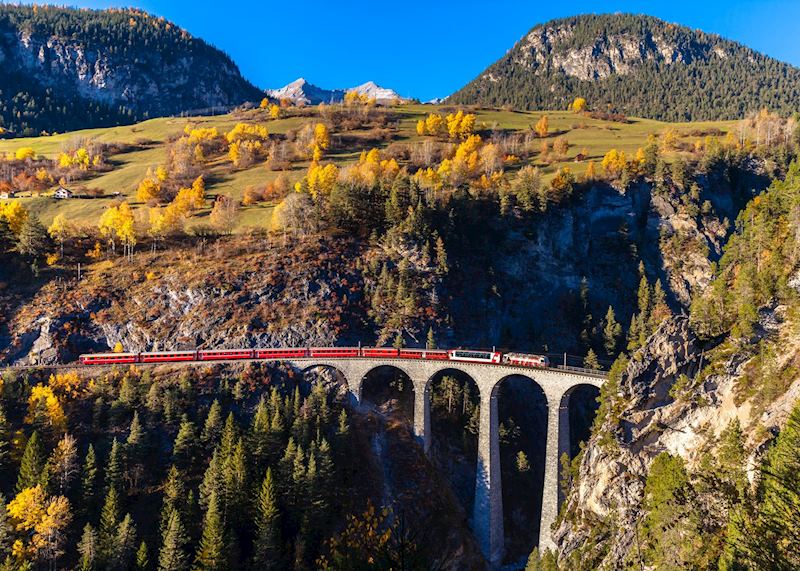
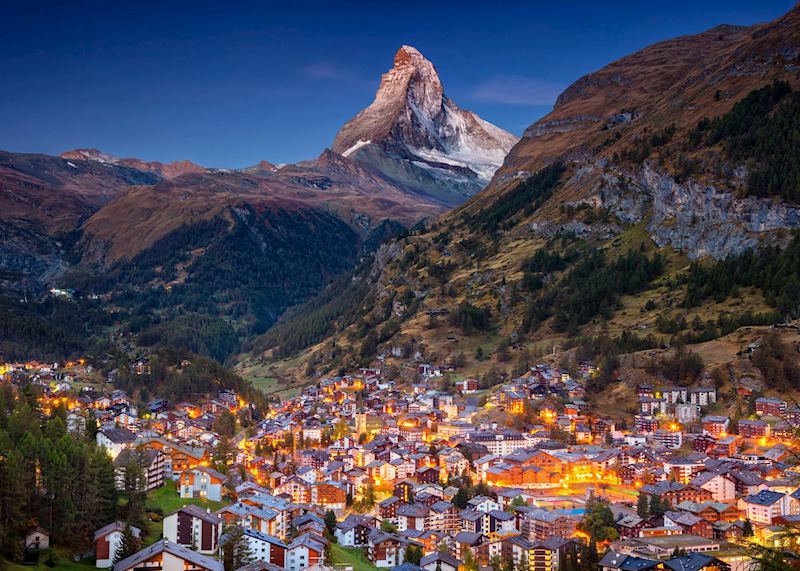
One of Europe’s oldest resort towns, Zermatt is shadowed by the shark-fin silhouette of the Matterhorn, which you can see wherever you go. Nestled among some of the Alps’ highest peaks, this has been a base for adventure since the 1860s, when English mountaineer Edward Whymper summited the mountain from here.
The town itself is compact and car-free, making it easy to stroll among the luxe hotels, glamorous boutiques and exceptional eateries. But the real attraction here remains the surrounding peaks. You can hike among the high Alpine meadows and over the nearby Gornergrat glacier, or take a gondola to the continent’s highest cable car station for top-of-the-world views.
To arrive in Zermatt in old-world style, we suggest taking the Glacier Express. Dubbed ‘the slowest express train in the world’, the train offers panoramic views out of its domed-glass train cars as it runs slowly (but non-stop) between St. Moritz and Zermatt. The see-through walls and ceilings offer some of the best views of the mountain landscapes year-round.
What to do in Zermatt: Ride an open-air train to Gornergrat, a jagged but accessible ridge among the Pennines, to visit the high-altitude glacier and take in views of the surrounding peaks.
Where to stay in Zermatt: Hotel Daniela offers a traditional Alpine experience in a Swiss-chalet-style hotel, with wool blankets made from the fleece of the hotel’s own sheep.
Zürich

Like a plump, contented cat basking in the Alpine sun, Zürich is Switzerland’s largest and wealthiest city, stretched out on the shores of a lake and a river. This is a well-run metropolis that often ranks among the most-livable cities in Europe, and the main shopping street, Bahnhofstrasse, overflows with exclusive boutiques. But there’s more to this handsome city than comfortable financiers and reliable trains.
You can stroll among the Roman-era old town to explore the medieval guild houses and churches — get your bearings with a walk through the car-free enclave. A highlight is Grossmünster, a cathedral with two towers that dates back to the 9th century. A private walking tour of the old town will help you understand why the cathedral’s walls are so severe and plain, a hint of the Protestant Reformation in Switzerland.
On the same tour, you’ll visit the nearby 13th-century Fraumünster, where five of the stained-glass windows were designed by Marc Chagall in the 1970s. His love of bright, transparent hues and strong, abstract shapes is perfectly suited for the medium.
For the best view of the city, you have to leave its confines to summit Uetliberg, a nearby mountain. It’s an easy walk of about two hours, or you can ride the funicular. At the peak, you can see the city and lake, as well as the distant Alps.
What to do in Zürich: A driving tour of the surrounding region gives you a chance to visit a Swiss chocolate shop, a cheesemaking factory, the brightly painted village of Appenzell and one of the nearby mountains.
Where to stay in Zürich: Marktgasse Hotel combines history with modern comforts. Its 600-year-old building is nestled among the shops and cafés of the old town, but the interior has clean, minimalist lines and an abundance of style.
Food & drink in Switzerland


Much of Switzerland’s cuisine has roots its bordering countries. You’ll find flaky pastries in the Francophone regions, spätzli and sausages in the German-speaking regions, and risotto and olive oil in Ticino, where they speak Italian. Over the years, restaurant chefs and home cooks have put their own stamp on these dishes, making them distinctly Swiss.
However, there are plenty of dishes that are unique to Swiss cuisine — most of them built around the abundance of cheese that’s produced in the Alps. A raclette dinner, for example, involves a large piece of the namesake cheese slowly melting as diners scrape off the gooey bits to drizzle over potatoes, pickles and dried meat.
To learn more, we can arrange for you to visit the Emmental Show Dairy, a tour that will take you to the home of Swiss cheese for a behind-the-scenes glimpse at the process.
Switzerland is also renowned for its chocolate — the Swiss eat more chocolate than anyone else in the world, about 9 kg (20 lb) per person annually. You’ll find delectable cocoa confections throughout the country, from the ubiquitous Toblerone to hand-made bonbons created by highly skilled chocolatiers. We can arrange for you to enjoy a tour and tasting at the country’s leading chocolate atelier.
While the country’s chocolate and cheese industries are renowned, its wine industry is perhaps Switzerland’s best-kept secret. The vineyards are located almost entirely in the Lavaux region, most along the sunny shores of Lake Geneva, growing in steep, lush terraces against the backdrop of the Central Alps.
Almost none of the local wines are sold outside the country, so you can only sample these vintages on a visit here. A private tour of a local vineyard will provide some insight into this ancient, but little-known, wine region.
Best time to visit Switzerland
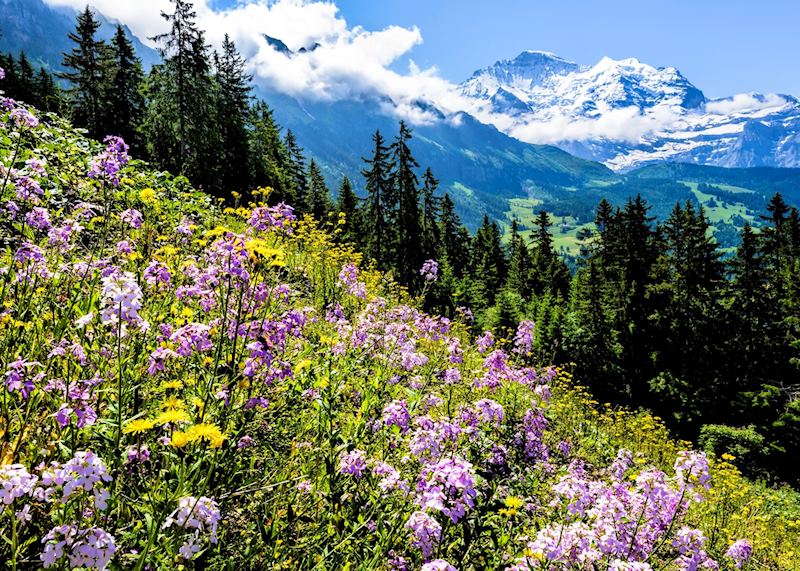
The best time to visit Switzerland depends largely on what you want to do while you’re there. For hiking in the Alps, the sunny summer months of June to August offer the best mountain scenery and good weather, with blue skies and moderate temperatures. This is the most popular time to visit, so plan ahead if you want your choice of stays.
You’ll find flower-filled meadows and cows returning to green valleys in the spring months of April and May. These months have slightly uncertain weather, with the occasional flurry of winter temperatures in April and a good chance of rain in May, but you’ll also find thinner crowds.
Harvest season and autumnal foliage are the main attractions in September and October. There are fewer people, but the days are shorter. November is often rainy and many of the hotels and attractions are shuttered for the month, but winter sport enthusiasts have long flocked to the Alps between December and March.
Getting around Switzerland
We can arrange private cars and private guides for all your tours and activities, to make your trip as smooth and hassle-free as possible. In the towns and cities, usually the best way to travel is on foot. Train stations are often centrally located, making it easy for you to reach your hotel.
For travel between cities and towns, Switzerland’s rail network is extensive, reliable and efficient. We can also arrange for you to have a travel pass that’s valid on trains, buses, trams and some boats. In the Alps, scenic trains offer panoramic views and exceptional service as you travel through the mountains.
Read more about trips to Switzerland
Start thinking about your experience. These itineraries are simply suggestions for how you could enjoy some of the same experiences as our specialists. They're just for inspiration, because your trip will be created around your particular tastes.
View All Tours in Switzerland